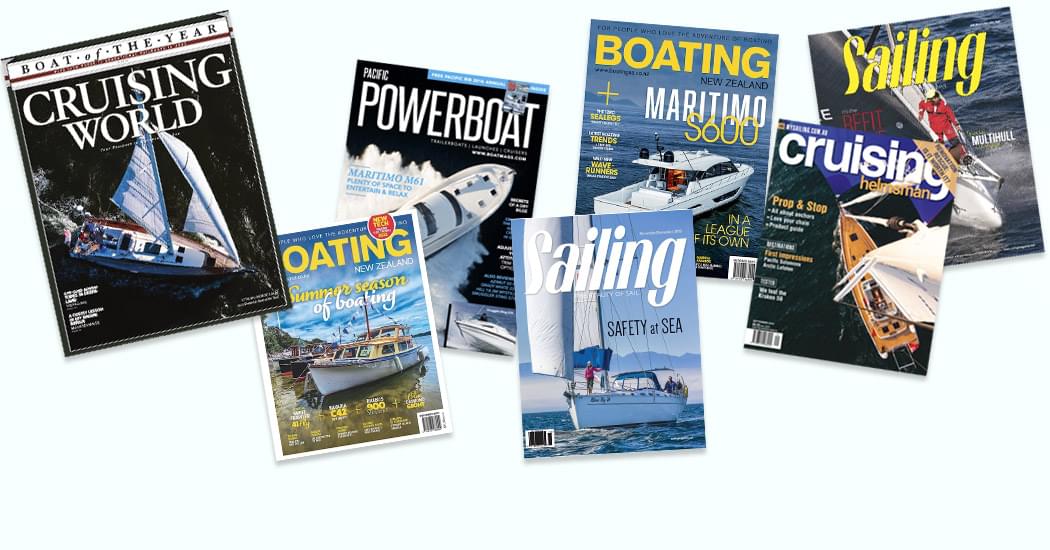
Cruising Helmsman
08 19 Topic : Yacht Reviews
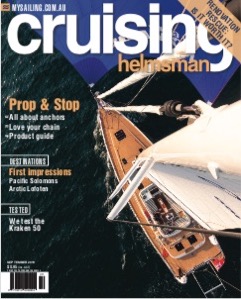
Cruising Helmsman - Dibley's Kraken 50
Sail Page - More Information about the Kraken 50
Comfort is not overrated
THE ROMANTIC IMAGE OF BLUEWATER SAILING IS OF DREAMY DRIFTING; WHILE THE TRUTH IS VASTLY DIFFERENT THE KRAKEN 50 HELPS EASE THAT REALITY.
PHIL ROSS
KEVIN Dibley has quietly gathered an excellent global reputation for both racing and cruising yachts. When it comes to designing dedicated bluewater cruising yachts, knowing how to mix those two factors efficiently is key.
Working with Kraken’s concept designer and Kraken founder, Dick Beaumont, Dibley has designed a yacht based on a tripod philosophy of redundancy, comfort and safety upon which all other components must sit.
REDUNDANCY
All winches are Harken and, while the correct size for each winch is calculated, the company installs the next size up. All Dyneema rope is used on the running rigging, which is strong, stiff and easily respliced and replaced.
Kraken are even looking at replacing the standing rigging with Dyneema in later models.
The engine room is a delight. Accessed on the starboard side behind the companionway steps, the engine space and machinery room is isolated with a vibration dampening plate and thick acoustic insulation with aluminium liner. Here you can access all the electrics and the generator.
A fuel polishing system is standard, connected to port and starboard tanks totalling 850 litres to the 60 kilowatt Yanmar. A fuel day tank sits above the keel. The fuel polishing occurs when fuel is swapped between the main tanks; to the day tank and once more to the engine itself.
In the galley, on the port side alongside the engine, there are two types of refrigeration, which can be set up to be isolated or connected to the owner’s preferred mix of refrigeration or freezer.
SAFETY
In a throwback to the old days of full body keels, the single piece hull construction includes what Kraken call its Zero keel; an internal, flat- bottomed lead ballast is incorporated into the hull and keel with Kevlar reinforcements on the leading edges to protect it from groundings.
A solid fiberglass hull below waterline extends 40 centimetres above, where foam core topsides deliver stiffness, rigidity and strength.
Transverse frames solidify the hull laterally and carry into the bilge to ensure connection and stress spreading from the keel through the whole structure. Six longitudinal stiffeners run the full length of the hull connected to the transverse frames and the hull laminate.
The rudder is fully-skegged for added protection, Kraken designer Dibley and Beaumont opted for its ‘belt and braces’ approach. Although the rudderstock and the full depth skeg are self-supporting, the skeg will absorb a large part of the energy from any grounding.
The propellor shaft is connected to the hull by a double V-bracket for redundancy and protection from underwater debris.
Every Kraken yacht is a dual-headed Solent rig as standard.
This style of rig provides choice of sail configurations to optimise sailing in all wind directions and strengths while remaining easy to handle by short-handed or family crews.
One of the philosophy’s imbued in the design of every item on a Kraken comes from founder Beaumont: “everything must be repairable by a tractor mechanic.” The realisation being that when overseas sometimes that is the best trade skills you can hope for.
COMFORT
There are a basic four different layout plans with changes to the saloon linked to either a two- cabin or a three cabin interior.
But Kraken want each owner to receive the yacht of their dreams, so the team of experienced sailors and designers discuss with each potential owner as to their passage expectations, destinations and crew requirements and tailor the layout, interior design and equipment to your choice. Each Kraken yacht is custom built to match the dream.
Given the comfort of the fitout and including the strong construction, this 50 footer does come out on the heavy side of other production yachts I have tested. Comparatively it is around 25 per cent heavier in displacement and 50% in ballast. The latter figure is not surprising considering the sizeable stingray-shaped encased Zero keel.
Designer Dibley compensates for this by producing a deep canoe body draft on a beamy yacht to spread the load. A flat run aft from the keel gives good stability. While all of this provides a stiff ballast ratio of 36% it is compensated with a larger sail area, when compared to other similar sized yachts, of around 25% more.
While the keel draft is much the same as other yachts, it is on a long keel, which adds markedly to the lateral stability and smooth motion in bluewater sea states.
What you end up with is a low centre of gravity on a smooth hull with plenty of power to drive it along.
With a comfortable ride sorted, let’s go back downstairs and check out the fitout. New owner of our test yacht Seneca was looking at utilising friends as crew to slowly expand his horizons over the coming years, with the intention of crossing oceans in a few years.
He opted for the two cabin layout and the wrap-around saloon table. Kraken yachts keep a close control on the quality and it shows.
Interior joinery is a beautiful cherry oak and decorative veneers. Giving that essential warmth that only wood interiors can give. Concealed hinges and quality latches on locker doors plus solid timber door frames add to the sense of quality in the build. Upholstery is either suede or a similar quality marine fabric for the cushions and headboards.
This is a yacht where you can move into one of its nooks and not only be comfortable, but also be safe and secluded.
The five step companionway ladder takes you deep into the hull but the deck saloon windows ensure good view and light all round. Directly to starboard is the dedicated navigation station in front of the entry to the engine room discussed earlier.
To port of the stairs is the access to the galley alongside the engine. A wet weather gear cupboard forward of this includes the inverter to heat the area and drip dry the oilskins.
I do like the galley alongside the engine: it is safe yet expansive, with plenty of room for benches and storage.
Walk through the galley leads into the master cabin. A large double bed raised high with easy access on both sides. Both sides also have side table space. His and hers hanging and storage sit either side and the master head is on the starboard side.
The head is right on the maximum beam, allowing room for a separate shower. The forward cabin head is set up much the same with a minimal reduction in footprint.
In the main saloon area the L-shaped lounge will sit six comfortably around the foldable table. Unfold the table and the port bench comes into play to allow dinner for eight.
Once again, not relying on what everyone else has done has seen a difference in the forecabin layout. The large double berth, forward of the mast bulkhead, is offset to starboard to maintain a sleeping position close to the yacht’s centre of gravity, keeping it comfortable when underway.
“THIS HULL IS NO SLOUCH AT ALL ANGLES AND WIND SPEEDS.”
There is tons of storage space, both hanging and drawer, plus even a small desk and chair to port.
That feeling of safety is replicated upstairs as well. The central T-shaped cockpit is deep, delivering a security that only central cockpits can provide. The cockpit is definitely designed to be a snug so the on-watch can stay for hours on end without a worry.
The downsides for this security is a climb to get in and out of the cockpit but, once again, I feel the emphasis is on the majority of use for the cocckpit will be sitting within its confines, movement on deck is minimal.
The steering station aft stretches across the cockpit to accommodate the large wheel. Vision from here is easy, even with the bimini and hard dodger.
All winches and line controls are to hand and The mainsheet traveller is out of the way aft of the cockpit for end boom sheeting.
Safety factor aside the other benefit of a centre cockpit is the lounging space it provides on the aft deck. Transom seats are a must.
ON THE WATER
Despite its relatively heavy displacement, this slick hull design means at 1600 revolutions per minute the 80 horsepower engine will push this 50 footer at a respectable 6.5 knots for usage of only four litres per hour. Open up the throttle slightly to 2100rpm and it will leap to 7.5kn with no noticeable drop in fuel consumption. With 850 litres of fuel tank as standard there is plenty to get you going.
Walking towards the yacht you notice its rather sleek profile. Dedicated bluewater yachts, especially with centre cockpits, are usually expected to look chunky and heavy. But designer Dibley has spent a lot of time designing fast and cruisy yachts and has found a lovely mix that is definitely pleasing to the eye.
The Solent rig and quite high aspect mast allows for a long foredeck; followed by a gentle sloping rise to the cabin top. You hardly notice the coamings around the centre cockpit.
To add to the tip of the hat to old style design is a nice bow and stern rake. The bow overhang ensures the anchor sits well clear.
We spent two days in Hong Kong taking this recently sold Kraken 50 in all types of weather. Needless to say it performed with flying colours.
Our first day involved sailing around Hong Kong Island, we got to experience all wind angles in mostly 10 to 15 knots.
The huge large forward locker stores all the necessary sails as well as the fenders and mooring lines; so getting the large spinnaker out and up was no hassle for our novice foredeck crew. In fact the locker can be converted to accommodate a couple of crew berths if requested.
This Code 0 spinnaker can be raised at around 80 degrees true wind angle and can hold up to 130° Seneca owner has opted for the symmetrical spinnaker as well to be able to run easily dead downwind.
“A TRIPOD PHILOSOPHY OF REDUNDANCY, COMFORT AND SAFETY.”
The velocity prediction program shows quite tight lines over all wind angles and wind speed range. Theoretical hull speed of nine knots is reached at 12 knots of true wind at 75° wind angle. It was obvious out on the water that this hull is no slouch at all angles and wind speeds.
The next day we headed out in a wet tropical autumn day to see how the yacht copes with high wind gusts accompanied with rain squalls. To be honest, we hardly noticed!
Standing at the wheel, under the bimini coming off the hard dodger, the gusts could be easily seen and, while the hull would heel to the added pressure, it was converted to forward motion fairly quickly with no weather helm showing at the wheel.
The helm is tight with little movement from the hydraulic quadrant. But it is responsive, while put under stress in those high winds and sporadic gusting, I could still hold the wheel with two fingers, seated comfortably and bear away with ease if required, under no helm pressure.
This baby will roll away the miles while keeping the smiles on its crew for many a year. The owner spent a long time finding the correct yacht for his desires and needs, he was incredibly lucky to find exactly what he wanted right in his hometown.
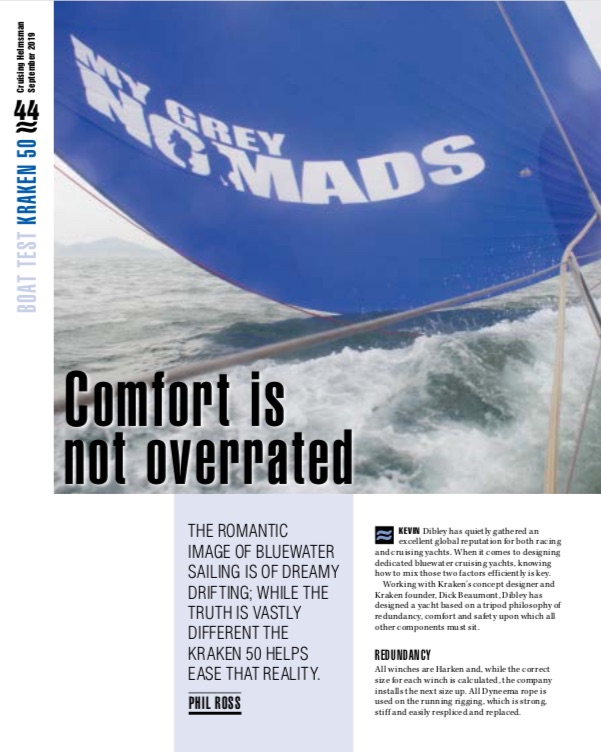
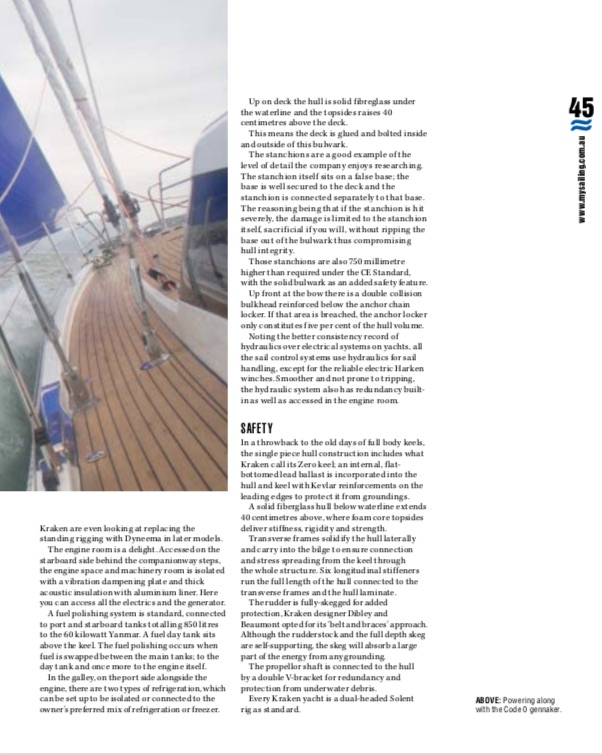
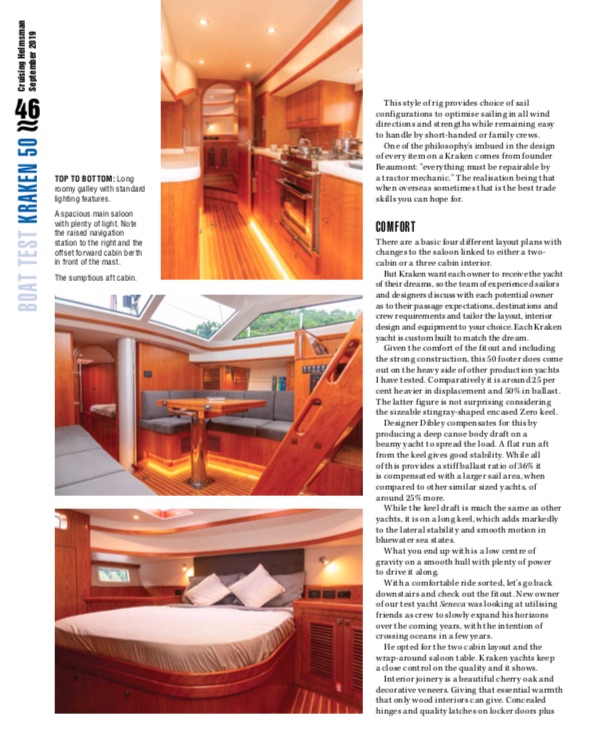
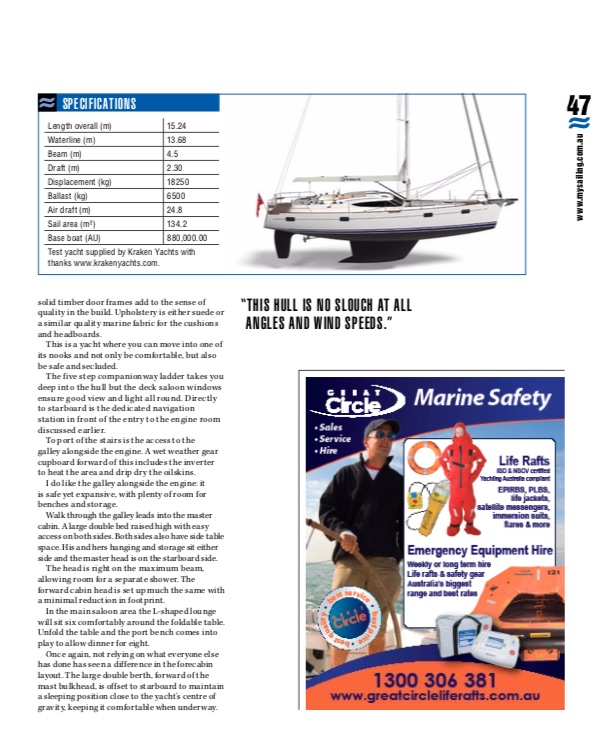
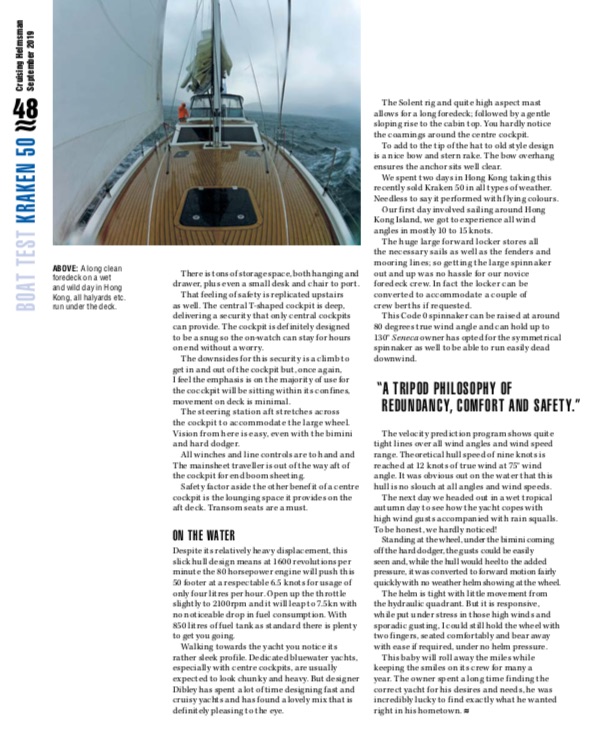
Sail Page - More Information about the Kraken 50
Comfort is not overrated
THE ROMANTIC IMAGE OF BLUEWATER SAILING IS OF DREAMY DRIFTING; WHILE THE TRUTH IS VASTLY DIFFERENT THE KRAKEN 50 HELPS EASE THAT REALITY.
PHIL ROSS
KEVIN Dibley has quietly gathered an excellent global reputation for both racing and cruising yachts. When it comes to designing dedicated bluewater cruising yachts, knowing how to mix those two factors efficiently is key.
Working with Kraken’s concept designer and Kraken founder, Dick Beaumont, Dibley has designed a yacht based on a tripod philosophy of redundancy, comfort and safety upon which all other components must sit.
REDUNDANCY
All winches are Harken and, while the correct size for each winch is calculated, the company installs the next size up. All Dyneema rope is used on the running rigging, which is strong, stiff and easily respliced and replaced.
Kraken are even looking at replacing the standing rigging with Dyneema in later models.
The engine room is a delight. Accessed on the starboard side behind the companionway steps, the engine space and machinery room is isolated with a vibration dampening plate and thick acoustic insulation with aluminium liner. Here you can access all the electrics and the generator.
A fuel polishing system is standard, connected to port and starboard tanks totalling 850 litres to the 60 kilowatt Yanmar. A fuel day tank sits above the keel. The fuel polishing occurs when fuel is swapped between the main tanks; to the day tank and once more to the engine itself.
In the galley, on the port side alongside the engine, there are two types of refrigeration, which can be set up to be isolated or connected to the owner’s preferred mix of refrigeration or freezer.
SAFETY
In a throwback to the old days of full body keels, the single piece hull construction includes what Kraken call its Zero keel; an internal, flat- bottomed lead ballast is incorporated into the hull and keel with Kevlar reinforcements on the leading edges to protect it from groundings.
A solid fiberglass hull below waterline extends 40 centimetres above, where foam core topsides deliver stiffness, rigidity and strength.
Transverse frames solidify the hull laterally and carry into the bilge to ensure connection and stress spreading from the keel through the whole structure. Six longitudinal stiffeners run the full length of the hull connected to the transverse frames and the hull laminate.
The rudder is fully-skegged for added protection, Kraken designer Dibley and Beaumont opted for its ‘belt and braces’ approach. Although the rudderstock and the full depth skeg are self-supporting, the skeg will absorb a large part of the energy from any grounding.
The propellor shaft is connected to the hull by a double V-bracket for redundancy and protection from underwater debris.
Every Kraken yacht is a dual-headed Solent rig as standard.
This style of rig provides choice of sail configurations to optimise sailing in all wind directions and strengths while remaining easy to handle by short-handed or family crews.
One of the philosophy’s imbued in the design of every item on a Kraken comes from founder Beaumont: “everything must be repairable by a tractor mechanic.” The realisation being that when overseas sometimes that is the best trade skills you can hope for.
COMFORT
There are a basic four different layout plans with changes to the saloon linked to either a two- cabin or a three cabin interior.
But Kraken want each owner to receive the yacht of their dreams, so the team of experienced sailors and designers discuss with each potential owner as to their passage expectations, destinations and crew requirements and tailor the layout, interior design and equipment to your choice. Each Kraken yacht is custom built to match the dream.
Given the comfort of the fitout and including the strong construction, this 50 footer does come out on the heavy side of other production yachts I have tested. Comparatively it is around 25 per cent heavier in displacement and 50% in ballast. The latter figure is not surprising considering the sizeable stingray-shaped encased Zero keel.
Designer Dibley compensates for this by producing a deep canoe body draft on a beamy yacht to spread the load. A flat run aft from the keel gives good stability. While all of this provides a stiff ballast ratio of 36% it is compensated with a larger sail area, when compared to other similar sized yachts, of around 25% more.
While the keel draft is much the same as other yachts, it is on a long keel, which adds markedly to the lateral stability and smooth motion in bluewater sea states.
What you end up with is a low centre of gravity on a smooth hull with plenty of power to drive it along.
With a comfortable ride sorted, let’s go back downstairs and check out the fitout. New owner of our test yacht Seneca was looking at utilising friends as crew to slowly expand his horizons over the coming years, with the intention of crossing oceans in a few years.
He opted for the two cabin layout and the wrap-around saloon table. Kraken yachts keep a close control on the quality and it shows.
Interior joinery is a beautiful cherry oak and decorative veneers. Giving that essential warmth that only wood interiors can give. Concealed hinges and quality latches on locker doors plus solid timber door frames add to the sense of quality in the build. Upholstery is either suede or a similar quality marine fabric for the cushions and headboards.
This is a yacht where you can move into one of its nooks and not only be comfortable, but also be safe and secluded.
The five step companionway ladder takes you deep into the hull but the deck saloon windows ensure good view and light all round. Directly to starboard is the dedicated navigation station in front of the entry to the engine room discussed earlier.
To port of the stairs is the access to the galley alongside the engine. A wet weather gear cupboard forward of this includes the inverter to heat the area and drip dry the oilskins.
I do like the galley alongside the engine: it is safe yet expansive, with plenty of room for benches and storage.
Walk through the galley leads into the master cabin. A large double bed raised high with easy access on both sides. Both sides also have side table space. His and hers hanging and storage sit either side and the master head is on the starboard side.
The head is right on the maximum beam, allowing room for a separate shower. The forward cabin head is set up much the same with a minimal reduction in footprint.
In the main saloon area the L-shaped lounge will sit six comfortably around the foldable table. Unfold the table and the port bench comes into play to allow dinner for eight.
Once again, not relying on what everyone else has done has seen a difference in the forecabin layout. The large double berth, forward of the mast bulkhead, is offset to starboard to maintain a sleeping position close to the yacht’s centre of gravity, keeping it comfortable when underway.
“THIS HULL IS NO SLOUCH AT ALL ANGLES AND WIND SPEEDS.”
There is tons of storage space, both hanging and drawer, plus even a small desk and chair to port.
That feeling of safety is replicated upstairs as well. The central T-shaped cockpit is deep, delivering a security that only central cockpits can provide. The cockpit is definitely designed to be a snug so the on-watch can stay for hours on end without a worry.
The downsides for this security is a climb to get in and out of the cockpit but, once again, I feel the emphasis is on the majority of use for the cocckpit will be sitting within its confines, movement on deck is minimal.
The steering station aft stretches across the cockpit to accommodate the large wheel. Vision from here is easy, even with the bimini and hard dodger.
All winches and line controls are to hand and The mainsheet traveller is out of the way aft of the cockpit for end boom sheeting.
Safety factor aside the other benefit of a centre cockpit is the lounging space it provides on the aft deck. Transom seats are a must.
ON THE WATER
Despite its relatively heavy displacement, this slick hull design means at 1600 revolutions per minute the 80 horsepower engine will push this 50 footer at a respectable 6.5 knots for usage of only four litres per hour. Open up the throttle slightly to 2100rpm and it will leap to 7.5kn with no noticeable drop in fuel consumption. With 850 litres of fuel tank as standard there is plenty to get you going.
Walking towards the yacht you notice its rather sleek profile. Dedicated bluewater yachts, especially with centre cockpits, are usually expected to look chunky and heavy. But designer Dibley has spent a lot of time designing fast and cruisy yachts and has found a lovely mix that is definitely pleasing to the eye.
The Solent rig and quite high aspect mast allows for a long foredeck; followed by a gentle sloping rise to the cabin top. You hardly notice the coamings around the centre cockpit.
To add to the tip of the hat to old style design is a nice bow and stern rake. The bow overhang ensures the anchor sits well clear.
We spent two days in Hong Kong taking this recently sold Kraken 50 in all types of weather. Needless to say it performed with flying colours.
Our first day involved sailing around Hong Kong Island, we got to experience all wind angles in mostly 10 to 15 knots.
The huge large forward locker stores all the necessary sails as well as the fenders and mooring lines; so getting the large spinnaker out and up was no hassle for our novice foredeck crew. In fact the locker can be converted to accommodate a couple of crew berths if requested.
This Code 0 spinnaker can be raised at around 80 degrees true wind angle and can hold up to 130° Seneca owner has opted for the symmetrical spinnaker as well to be able to run easily dead downwind.
“A TRIPOD PHILOSOPHY OF REDUNDANCY, COMFORT AND SAFETY.”
The velocity prediction program shows quite tight lines over all wind angles and wind speed range. Theoretical hull speed of nine knots is reached at 12 knots of true wind at 75° wind angle. It was obvious out on the water that this hull is no slouch at all angles and wind speeds.
The next day we headed out in a wet tropical autumn day to see how the yacht copes with high wind gusts accompanied with rain squalls. To be honest, we hardly noticed!
Standing at the wheel, under the bimini coming off the hard dodger, the gusts could be easily seen and, while the hull would heel to the added pressure, it was converted to forward motion fairly quickly with no weather helm showing at the wheel.
The helm is tight with little movement from the hydraulic quadrant. But it is responsive, while put under stress in those high winds and sporadic gusting, I could still hold the wheel with two fingers, seated comfortably and bear away with ease if required, under no helm pressure.
This baby will roll away the miles while keeping the smiles on its crew for many a year. The owner spent a long time finding the correct yacht for his desires and needs, he was incredibly lucky to find exactly what he wanted right in his hometown.





Sail Page - More Information about the Kraken 50
